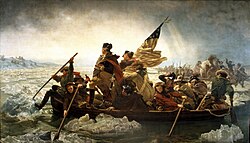 First edition | |
| Author | David Hackett Fischer |
|---|---|
| Cover artist | Emanuel Leutze, Washington Crossing the Delaware - 1851 |
| Genre | Non-fiction |
| Publisher | Oxford University Press |
Publication date | 2004 |
| Pages | 576 |
| ISBN | 0-19-517034-2 (hardcover) ISBN 0-19-518159-X (paperback) |
| OCLC | 53075605 |
| 973.3/32 22 | |
| LC Class | E263.P4 F575 2004 |
Washington's Crossing is a Pulitzer Prize-winning book written by David Hackett Fischer and part of the "Pivotal Moments in American History" series. It is primarily about George Washington's leadership during the 1776 campaign of the American Revolutionary War, culminating with George Washington's crossing of the Delaware River and the subsequent campaign, with the Battle of Trenton, the Battle of the Assunpink Creek, and the Battle of Princeton.
Contents
The main theme of Fischer's book is the concept of contingency history, one major theory of history. Contingency history is the idea that people's decisions matter, and it is because of these decisions that certain events take place. Washington's decisions changed the course of the Revolutionary War and ultimately led the Continental Army to victory.


